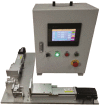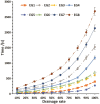Effect of Multiple Factors on Foam Stability in Foam Sclerotherapy
- PMID: 30356108
- PMCID: PMC6200734
- DOI: 10.1038/s41598-018-33992-w
Effect of Multiple Factors on Foam Stability in Foam Sclerotherapy
Abstract
Foam sclerotherapy is a widely used treatment for varicose veins. However, complications caused by poor foam stability still remain. Most studies ignore multiple influencing factors and only study a single factor. Furthermore, a stable foam preparation using different preparation conditions has not been developed. This study aimed to explore the changing laws of foam stability under multifactorial conditions, and to determine the influence of various factors and optimal preparation conditions on the half-life of foam. A two-level orthogonal test was conducted using four factors (syringe size, surfactant, preparation temperature, and pump speed). Classifications were established as follows: syringe sizes, 2.5 mL and 5 mL; surfactant concentrations, 6% and 0%; preparation temperatures, 20 °C and 10 °C; and pump speeds, 250 mm/s and 125 mm/s, respectively. Eight experimental group (EG) multi-factor combinations were tested. Half-life and drainage time were recorded for analysis. The initial drainage time was within 200 s, but the difference between the groups was also about 200 s. The drainage rate curves of all EGs gradually increased over time. Conversely, the foam half-life extended by about 10 times for the four factors. In addition, the analyses revealed that the order of influence was surfactant >temperature >pump speed >syringe size. The most stable foam preparation was determined. Syringe size, surfactant, temperature, and pump speed had markedly observable influences on foam half-life. A combination of multiple factors can be used to prepare a more stable foam in clinical scenarios and to suitably superimpose favorable conditions to avoid unfavorable conditions.
Conflict of interest statement
The authors declare no competing interests.
Figures
Similar articles
-
Influence of Syringe Volume on Foam Stability in Sclerotherapy for Varicose Vein Treatment.Dermatol Surg. 2018 May;44(5):689-696. doi: 10.1097/DSS.0000000000001402. Dermatol Surg. 2018. PMID: 29140865
-
Studies on Foam Decay Trend and Influence of Temperature Jump on Foam Stability in Sclerotherapy.Vasc Endovascular Surg. 2018 Feb;52(2):98-106. doi: 10.1177/1538574417741786. Epub 2017 Nov 26. Vasc Endovascular Surg. 2018. PMID: 29173136
-
A comparison of different surfactants on foam stability in foam sclerotherapy in vitro.J Vasc Surg. 2019 Feb;69(2):581-591.e1. doi: 10.1016/j.jvs.2018.02.033. Epub 2018 Jun 25. J Vasc Surg. 2019. PMID: 29954633
-
A Review of Sclerosing Foam Stability in the Treatment of Varicose Veins.Dermatol Surg. 2020 Feb;46(2):249-257. doi: 10.1097/DSS.0000000000002039. Dermatol Surg. 2020. PMID: 31569112 Review.
-
Novel developments in foam sclerotherapy: Focus on Varithena® (polidocanol endovenous microfoam) in the management of varicose veins.Phlebology. 2018 Apr;33(3):150-162. doi: 10.1177/0268355516687864. Epub 2017 Feb 6. Phlebology. 2018. PMID: 28166694 Review.
Cited by
-
Efficacy and safety of hyaluronic-polidocanol foam in sclerotherapy for head and neck venous malformations.Front Neurol. 2024 Aug 16;15:1444896. doi: 10.3389/fneur.2024.1444896. eCollection 2024. Front Neurol. 2024. PMID: 39220735 Free PMC article.
-
Foam sclerotherapy compared with liquid sclerotherapy for the treatment of lower extremity varicose veins: A protocol for systematic review and meta analysis.Medicine (Baltimore). 2020 May 29;99(22):e20332. doi: 10.1097/MD.0000000000020332. Medicine (Baltimore). 2020. PMID: 32481409 Free PMC article.
-
Foam-in-Vein: Characterisation of Blood Displacement Efficacy of Liquid Sclerosing Foams.Biomolecules. 2022 Nov 22;12(12):1725. doi: 10.3390/biom12121725. Biomolecules. 2022. PMID: 36551153 Free PMC article.
-
Surface characteristics and molecular interactions of thin films between bubbles by molecular simulations.Front Chem. 2025 Jan 6;12:1493571. doi: 10.3389/fchem.2024.1493571. eCollection 2024. Front Chem. 2025. PMID: 39834846 Free PMC article.
-
Development of Glycerol-Rose Bengal-Polidocanol (GRP) foam for enhanced sclerosis of a cyst for cystic diseases.PLoS One. 2021 Jan 5;16(1):e0244635. doi: 10.1371/journal.pone.0244635. eCollection 2021. PLoS One. 2021. PMID: 33400697 Free PMC article.
References
-
- Figueiredo LM, Trindade SC, Sarmento VA, Muniz WR, Valente RO. Extensive gingival hemangioma in a 10-year-old boy treated by sclerotherapy: a case report. Journal of Oral & Maxillofacial Surgery Official Journal of the American Association of Oral & Maxillofacial Surgeons. 2012;70:2585–9. doi: 10.1016/j.joms.2011.11.028. - DOI - PubMed
-
- Bergan JJ, Cheng VL. Journal of Vascular & Interventional Radiology. 2008. Foam sclerotherapy: a textbook; pp. 1263–1263.
Publication types
MeSH terms
Substances
LinkOut - more resources
Full Text Sources






